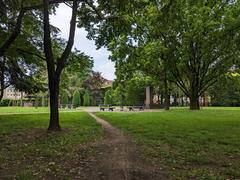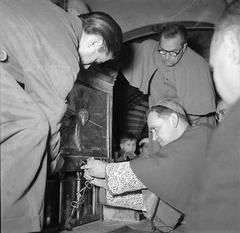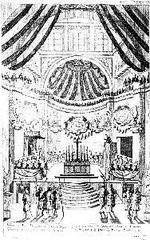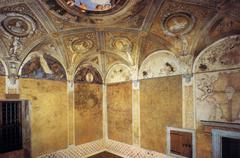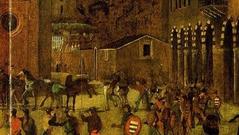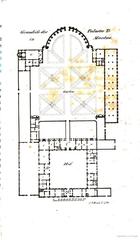
Palazzo dell’Accademia Nazionale Virgiliana: A Comprehensive Guide to Visiting Hours, Tickets, and Mantua’s Historical Heritage
Date: 04/07/2025
Introduction
In the heart of Mantua, Italy, the Palazzo dell’Accademia Nazionale Virgiliana stands as a beacon of the city’s intellectual, artistic, and architectural legacy. Established in 1768 under the patronage of Empress Maria Theresa of Austria, this neoclassical masterpiece pays homage to Mantua’s most illustrious native, the Roman poet Virgil. Today, the palazzo serves as a vibrant center for cultural exchange, scholarly activity, and artistic performance, welcoming visitors to experience the living history of Mantua’s UNESCO-listed old town (Accademia Nazionale Virgiliana, Comune di Mantova, finestresullarte.info, thetravelfolk.com).
Table of Contents
- Historical Overview
- Visiting the Palazzo
- Visitor Tips and Practical Information
- Frequently Asked Questions (FAQ)
- Conclusion
- References
Historical Overview
Origins and Foundation
The roots of the Accademia Nazionale Virgiliana reach back to the mid-16th century, when the Accademia degli Invaghiti was established as a forum for literature, science, and the arts. In 1768, Empress Maria Theresa of Austria formalized the Accademia Virgiliana, aiming to promote Enlightenment values and honor the legacy of Virgil. Since then, the institution has been a nucleus for intellectual exchange in northern Italy (Accademia Nazionale Virgiliana).
Architectural Evolution
The palazzo’s core structure dates to the 16th century but underwent significant transformations in the late 18th century. Architect Paolo Pozzo redesigned the interiors with a harmonious neoclassical style, while Giuseppe Piermarini and Antonio Galli Bibiena contributed to the iconic Aula Magna and the Teatro Scientifico Bibiena. These spaces, adorned with allegorical frescoes and refined ornamentation, reflect the Enlightenment ideals of rationality and grandeur (Quaderno n. 17).
Cultural and Intellectual Significance
For over 250 years, the Accademia has fostered research and public engagement in literature, science, philosophy, and the arts. Its halls have hosted influential lectures, scientific demonstrations, and performances, connecting Mantua’s intellectual community with the broader European sphere. The library and archives house rare manuscripts, including annotated editions of Virgil’s works and correspondence from Enlightenment scholars (Studi Virgiliani, 1930).
Notable Events and Figures
Key events at the palazzo include the inaugural session under Maria Theresa, pioneering scientific lectures, and major artistic performances. Renowned figures associated with the Accademia include architect Paolo Pozzo, scholar Giuseppe Albini, scientist Angelo Gualandris, and members of the Gonzaga family (L’Eneide tradotta da Giuseppe Albini, 1921, L’Archivio Gonzaga di Mantova).
Visiting the Palazzo dell’Accademia Nazionale Virgiliana
Opening Hours
- Tuesday to Sunday: 9:00 AM – 6:00 PM
- Closed: Mondays and major public holidays (e.g., January 1, December 25).
- Special Hours: Occasionally on select holidays (e.g., April 21, June 2, December 8).
Always confirm up-to-date hours on the official website or BeCulture ticketing.
Tickets and Admission
- Standard Entrance: Typically €4–€8, with reductions for students, seniors, and children under 12.
- Guided Tours: Available in Italian and English for an additional fee; advance booking recommended.
- Combined Tickets: Consider a joint ticket with the Teatro Scientifico Bibiena for a comprehensive visit.
- Ticket Purchase: Online via BeCulture ticketing or at the entrance, subject to availability.
Accessibility
- Wheelchair accessible entrances, elevators, and restrooms are provided.
- Assistance for visitors with disabilities can be arranged upon request.
How to Get There
- Address: Via Accademia, 47, 46100 Mantova MN, Italy
- By Train: 15-minute walk from Mantua railway station.
- By Bus: Served by local bus routes; limited parking in the city center.
- On Foot: Easily accessible from Piazza Sordello, the Ducal Palace, and other key landmarks (thetravelfolk.com).
Highlights and Nearby Attractions
Architectural and Artistic Features
- Sala Piermarini: Neoclassical main hall for academic sessions and performances.
- Teatro Scientifico Bibiena: Exquisite 18th-century theater, famed for its bell-shaped plan and exceptional acoustics; Mozart performed here at age 13 (finestresullarte.info).
- Library and Archives: Over 40,000 volumes, including rare Virgilian editions and Enlightenment-era correspondence.
- Art Collections: Portraits, frescoes by Giovanni Cadioli, medals, and period furnishings.
Nearby Mantua Historical Sites
- Ducal Palace (Palazzo Ducale): Expansive Renaissance complex with frescoes and gardens.
- Basilica of Sant’Andrea: Masterpiece by Leon Battista Alberti.
- Rotonda di San Lorenzo: Mantua’s oldest church.
- Teatro Sociale and Piazza Sordello: Key sites in Mantua’s UNESCO urban landscape.
Special Events and Cultural Activities
- Concerts and Exhibitions: Chamber music, art exhibitions, and literary festivals, most notably the annual Festivaletteratura.
- Educational Initiatives: Workshops, lectures, and programs for students and the public.
- International Virgil Prize: Biennial event promoting Virgilian studies (en.wikipedia.org).
Visitor Tips and Practical Information
- Book in Advance: Particularly for guided tours and Bibiena Theater events.
- Best Times: Early mornings or weekdays for quieter visits; September for Festivaletteratura.
- Dress Comfortably: Mantua’s city center is best explored on foot.
- Photography: Non-flash photos allowed in public spaces; restrictions may apply during events.
- Accessibility: Contact the venue in advance for detailed information or special needs (accademianazionalevirgiliana.org).
- Amenities: Restrooms and cloakroom available; gift shop on-site.
Frequently Asked Questions (FAQ)
Q: What are the Palazzo dell’Accademia Nazionale Virgiliana visiting hours?
A: Open Tuesday to Sunday, 9:00 AM–6:00 PM. Closed Mondays and major holidays. Check the official website for updates.
Q: How much do tickets cost?
A: Standard admission is €4–€8, with discounts for eligible visitors.
Q: Are guided tours available?
A: Yes, in Italian and English. Advance booking is recommended.
Q: Is the Palazzo accessible for visitors with disabilities?
A: Yes, most areas are accessible. Contact for specific needs.
Q: Can I take photographs?
A: Non-flash photography is generally permitted except during performances or special exhibitions.
Conclusion
Visiting the Palazzo dell’Accademia Nazionale Virgiliana is an essential experience for anyone exploring Mantua. From its origins as a Renaissance intellectual hub to its present role as a dynamic center of culture and scholarship, the palazzo offers a window into centuries of artistic, scientific, and civic achievement. Make the most of your journey by booking tickets in advance, joining a guided tour, and exploring the vibrant surroundings of Mantua’s UNESCO-listed center. For updates, event listings, and travel tips, consult the official website and consider using resources like the Audiala app.
References
- Accademia Nazionale Virgiliana
- Comune di Mantova
- finestresullarte.info
- thetravelfolk.com
- Mantova Turismo
- Festivaletteratura
- BeCulture Ticketing
- en.wikipedia.org
- minube.it
- mantova.com
- UNESCO World Heritage



